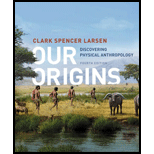
Concept explainers
Introduction: In taxonomical order, primate members belong to animal groups. They are different from mammals and found all over the world. They have a unique combination of traits. The dental pattern of primates are different from others. They possess forward-facing eyes and grasping hands and feet.
Answer to Problem 1SQ
Correct answer: c.
Explanation of Solution
Reason for the correct answer:
According to the angiosperm radiation hypothesis, the availability of fruits and flowers are acquired by primates with the help of visual acuity and grasping hands. This is because of the spread of angiosperms in the early Cenozoic. Thus, this hypothesis specifically linked with the evolution of primates.
Option c. is given as “angiosperm radiation hypothesis”.
Hence, the correct answer is option c.
Reasons for incorrect answers:
Option a. is given as “arboreal hypothesis”.
The arboreal hypothesis explains the evolution of primates based on their unique adaption to living on trees. Therefore, option a is incorrect.
Option b. is given as “visual predation hypothesis”.
This hypothesis reveals the characters of primates are an adaptation to prey on small insects and animals. Therefore, option b. is incorrect.
Option d. is given as “gymnosperm radiation hypothesis”.
There is no gymnosperm radiation hypothesis that exists for the evolution of primates. Therefore, option d. is incorrect.
Hence, options a., b., and d. are incorrect.
Thus, the angiosperm radiation hypothesis specifically links the evolution of primates.
Want to see more full solutions like this?
- The production of megaphylls by many different species of plants is an example of _____. a. parallel evolution b. analogy c. divergent evolution d. homologyarrow_forwardLook at picture attached A) What does the phylogeny suggest about the evolutionary process that led to the trait differences by habitat? a. convergent evolution b. adaptive radiation c. phenotypic plasticity B) Choose different functional forms from two of the habitats shown in the collage and describe how one or more differences in form may represent an adaptation to their different environment. Example: compare plant form for lobeliads in montane bog to cloud forest understoryarrow_forwardWhich factor most likely caused animals and plants in India todiffer greatly from species in nearby southeast Asia?(A) The species became separated by convergent evolution.(B) The climates of the two regions are similar.(C) India is in the process of separating from the rest of Asia.(D) India was a separate continent until 45 million years ago.arrow_forward
- Can you answer my questions. Lucy's relatives probably lived in an environment consisting of A. riverine forests and lake margins B. dry/hot desert conditions C. high tundra, grassland-areas D. savanna grasslands Which of the following is NOT one of the proposed hypotheses for the evolution of bipedalism? A. The need for a more efficient mode of locomotion B. The need to reach fruit and leaves on taller bushes C. The need to have free hands for carrying offspring and tool use D. The need to express symbolic meaning through cave painting The Great Rift Valley in Africa A. is a fossil-rich, geographic area that extends from Ethiopia to Tanzania B. has produced the most Neanderthal fossils to date C. has not produced any hominid fossils. D.arrow_forwardStudies of preagricultural populations indicate that compared to people today, Paleolithic people ate a. food that contained more fat and less fiber. b. food that had fewer essential nutrients. c. mostly meat. d. a wider variety of food.arrow_forwardBoth octopuses and cuttlefish have a single-lens eye. Their common ancestor also had a single-lens eye. What word describes the relationship between the octopus eye and the cuttlefish eye? a. homologous c. analogous b. vestigial d. convergentarrow_forward
- Ground beetles (Carabus solieri) have useless hind wings. In relatedspecies, the hind wings function in flight. What term describes groundbeetles’ hind wings?a. homeotic c. analogousb. vestigial d. convergentarrow_forwardThe earliest ancestor of land plants resembled: A)Grasses B)Red algae C)Green algae D)Ferns E)Pine treesarrow_forwardWhy is it interesting that Homo luzonensis was found on an island? A. The islands only formed after Homo luzonensis became extinct, so Neanderthals must have put them on the island B. The islands were a few miles apart, and Homo luzonensis would have needed to either float by grabbing on a tree or make a raft C. The islands were a few miles apart, and Homo luzonensis clearly had to learn how to fly to get to them D. The islands were volcanoes when Homo luzonensis was alive, so it's unexpected that they were therearrow_forward
- The fossils of extinct giant animals that Darwin found in Argentina, provided evidence that ... Group of answer choices A: people were eaten by dinosaurs B: animals had better diets in the past, so they grew larger C: supported the idea of catastrophism D: species changearrow_forwardFossil insects many times larger than any insects alive today have been dated to the Carboniferous and Permian periods. These fossils are evidence that during these periods a. the climate was much warmer than it is today. b. the oxygen concentration of the atmosphere was significantly higher than it is today. c. the carbon dioxide concentration of the atmosphere was lower than it is today. d. insects had fewer competitors for food than modern insects. e. there were fewer predators on insects than there are today.arrow_forwardAccording to Gould, what evidence did Darwin look for in specimens? A. Evidence of biological parts that are strange and odd B. Evidence of a perfect natural purpose to biological parts C. Evidence of intelligent designarrow_forward

 Biology (MindTap Course List)BiologyISBN:9781337392938Author:Eldra Solomon, Charles Martin, Diana W. Martin, Linda R. BergPublisher:Cengage Learning
Biology (MindTap Course List)BiologyISBN:9781337392938Author:Eldra Solomon, Charles Martin, Diana W. Martin, Linda R. BergPublisher:Cengage Learning Concepts of BiologyBiologyISBN:9781938168116Author:Samantha Fowler, Rebecca Roush, James WisePublisher:OpenStax College
Concepts of BiologyBiologyISBN:9781938168116Author:Samantha Fowler, Rebecca Roush, James WisePublisher:OpenStax College


